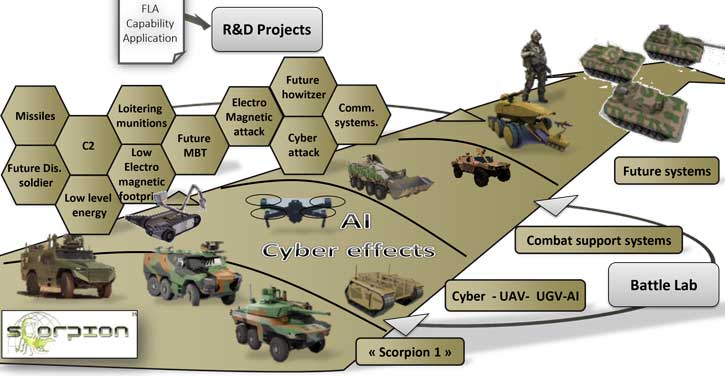Germany and France began to harmonize requirements and concepts, with the intention to formalize joint system architecture for their future main battle tank, currently known as the ‘Main Ground Combat System’ (MGCS). This future combat system is expected to succeed the Bundeswehr’s Leopard 2 and the French Army’s Leclerc beginning in 2035. Lead by the German side, MGCS is one of two major collaborations between France and Germany. The second program is the Future Combat Air System (FCAS), lead by France, in cooperation with Germany and Spain.
The aim of the study is to harmonize the operational requirements of the two armies into the final MGCS concepts drawn in the previous phase, to analyze further details, and to propose a common multi-platform architecture. The three contractual partners will assess various aspects of different concepts including:
- Technical feasibility in the projected timeframe allotted for the program
- Ability to fulfill the operational needs of both armies
- Efficiency and compatibility with national “systems of systems” (SCORPION for
France and Digitization of Land-Based Operations (D-LBO) for Germany).
What would the MGCV look like? too early to tell, but most likely, MGCS will be a family of heavy combat vehicles, that will provide the core of heavy, most lethal, and highly protected element, built to dominate any one-on-one direct effect engagement against peer opponent in a future battlespace. Most charts depict MGCS as a group of vehicles delivering a balanced ‘triangle’ – firepower, maneuver, and survivability.
[wlm_nonmember]![]() Subscribe to read the full article[/wlm_nonmember]
Subscribe to read the full article[/wlm_nonmember]
[wlm_ismember]The main idea is for a multi-platform MGCS is to deliver the full set of capability requirements without any supplements and support outside the MGCS formation. High mobility and agility mean smaller size, derived by the use of unmanned, automated turret. Such a design alleviates the requirement for full vehicle protection, leaving heavy armor to protect only the most sensitive elements – the small crew capsule, gun, ammunition, and drive train. The main armament will be 130 or even 140mm guns, that will overmatch any Russian tank. Some MGCS elements will mount weapons other than the main gun, which could include ultra-fast (a.k.a. hypervelocity) missiles and high energy lasers.

The French view derives from the evolution of the current combat formation ‘Scorpion’, and its adaptation to meet and defeat peer opponent. The French MGCS concept will be fully integrated into the Army’s future SCORPION operational network, offering high mobility, optimized protection, firepower, information management, and manned/unmanned cooperation.[/wlm_ismember]

The formal commitment to the MGCS joint program was given at the Franco-German Ministerial Council meeting in Toulouse on 16 October 2019, by the defense ministers of both nations, Florence Parly and Annegret Kramp-Karrenbauer. Two months later, in December 2019, Krauss-Maffei Wegmann (KMW), Nexter Systems, and Rheinmetall AG established the ARGE working group (ARGE is the German acronym standing for Arbeitsgemeinschaft, or “working group”.) The signature of the contract last week, for the 20-month ‘System Architecture Definition Study Stage-I’ (SADS Part 1), marked the beginning of the MGCS Demonstration Phase. An investment of up to €150 million for SADS Part I will be split equally between Germany and France. Commencing in 2028, the procurement phase will likely be managed under the European cooperative defense equipment organization – OCCAR. Workshares in the SADS Part 1 are to be distributed equally between France and Germany.

[wlm_ismember]The contract was digitally signed by the German Federal Office of Bundeswehr Equipment, Information Technology and In-Service Support (BAAINBw), acting in the name of both countries, as Germany is the lead nation of the bilateral project. Although ARGE serves as the contractual partner for BAAINBw for the MGCS joint project, officials from the three companies represented by ARGE signed the agreement.
This first step is a major milestone for the €1.5 billion R&D investment, but, true to its name, it will not deliver a combat system anytime soon. The follow-on system of technology demonstration and full-scale development phase will span the years 2024-2027, delivering the first examples of new systems for testing, culminating in the prototype vehicles and its systems. By 2028 the program is expected to move into early production engineering, presenting the first opportunity to deliver pre-production tanks for operational trials. The first production vehicles are scheduled for delivery in 2035 could achieve initial operational capability (IOC) five years later, in 2040.[/wlm_ismember]




















